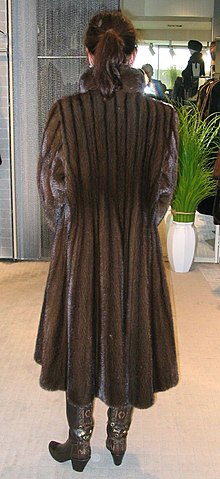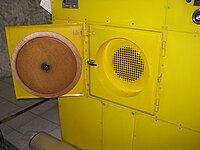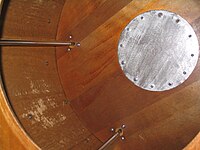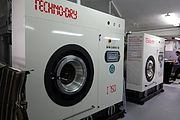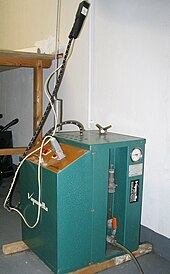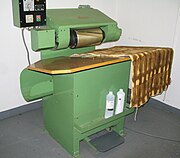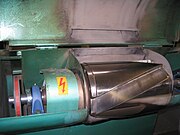Fur cleaning
The classic fur cleaning is still the refining -called clean using wood flour, originally only by the furrier . Especially in connection with outer fabrics (fabric clothing with fur lining) as well as fur velor and napped fur , fur clothing is now also dry- cleaned by companies specializing in fur and leather.
General
Until the Middle Ages, except for occasional knocking, furs were probably not cleaned at all during their lifespan; In particular, the more rustic types of fur hardly show any soiling. At the beginning of the 18th century, the still preserved cabinet accounts of the Electress Anna Maria von der Pfalz show five documents from her Düsseldorf court purveyor about the “cleaning” or “cleaning” of fine fur, and the bleaching of worn clothing is already documented there.
While in Germany the shortest cleaning interval is usually recommended once a year by specialist dealers only for sensitive types of fur or particularly stressed fur, the specialist literature in the USA even suggests cleaning these parts several times within a year. As far as this happens in the lautering process, the fur does not suffer; it is mainly a question of cost.
The cleaning of fur, with its many different types of fur, which can be treated differently, requires much more knowledge of the goods than cleaning textiles. The parts to be cleaned are often very old and therefore rotten in the leather. The old hair is often covered and yellowed by the dirt. The work process is also significantly more complex and differentiated.

On the right on the worktop is a hand tapping machine (1910).
Until after the Second World War , furs in Germany were only cleaned by furriers. In the United States, where the manufacture of large fur clothing had already reached a level of specialization never reached in Germany at the beginning of the 20th century, this work had long since been largely taken over by special fur cleaning companies. They got their orders from the various fur retail companies. In Europe, it was the Italians who were the first to give the fur "the finishing touch" with a special hair treatment, the so-called finish . The first such special cleaners in the Federal Republic were on the one hand the company Pelz-Neu in Hachenburg, whose owner brought his knowledge of new finishing methods and the necessary finishing devices with him from the USA. Based on the American model, he set up a pick-up service that picked up the furs from furriers, fur retailers and cleaning acceptance points on site. In 1955 , the old fur dressing and finishing company Thorer & Co. from Offenbach am Main, originally based in the fur city of Leipzig at Brühl, which is legendary in the industry since 1883 , also specialized under the name Thorer Finish . It set up several branches in Germany, including in West Berlin, which was then in the middle of the GDR . Further, mostly smaller companies were founded during the decades of the fur boom in the second half of the 20th century. In the GDR there had also been a special fur cleaning company in Leipzig since the 1950s, the process of which had been developed by a master furrier.
Collection points for fur cleaning are fur shops, furriers or textile cleaners. In the furrier business, depending on the machine and personnel equipment, the type of job and, last but not least, the professional's personal assessment of his abilities compared to the fur cleaning specialist, the accepted orders are carried out in their own workshop or they are passed on to the special cleaner. Before delivery to the end customer, he also checks the work that has not been carried out in-house, has detached fasteners that are not resistant to cleaning sewn on again, removes any cleaning flour that may have gotten under the lining and repairs minor damage, such as cracks.
The cleaning of fur velor and fur nappa (nappalan) as well as fur-lined textiles, provided the fur has not been separated from the fabric, always requires a special cleaner with its machine.
The Preparation of fur , tanning Rohfellen , places special demands on the cleaning, but the skins are heavily polluted in certain circumstances and odor loaded, encrusted with blood or contaminated with axle grease, delivered. When the prepared pelts leave the factory, they must have the most appealing hair and leather look. The fur dresser and fur refiner knows not only the so-called Gutlautern but also the lautering, the moist lautering, the clinging as well as the lautering in the hair and the lautering in the leather. Fur lautering in fur refiners is divided into several types: lautering during dressing (tanning), during dyeing and for special purposes (e.g. to remove excess dye). It helps to improve the grip of the fur leather; to make the leather “beautiful”, that means to make it whiter; to improve the shine and grip of the hair; for hair degreasing as well as to avoid electrostatic charge. Not all lautering processes actually serve to clean the fur. The optimal fur cleaning result is based on the standard achieved in the processing industry.
While essential tests related to the individual leather type were worked out for the assessment of leather, in 1976 the creation of test programs for fur skins was still in the initial stages; for noble fur no significant statements based on systematic tests had yet been made. New findings have probably not been made known since then. There are only tests for so-called utility furs that allow extensive statements to be made about both the fur leather and its usability. Since the condition of the pelts to be cleaned is of essential importance for the cleaning ability , the investigation of the acidity conditions , i.e. the pH value and the shrinkage temperature , is particularly important if cleaning with solvents is necessary . This allows statements to be made as to whether the fur material has sufficient strength that is retained for the longer period of wear. There must be no free acids in the fur leather, which can lead to destruction over time, and on the other hand it must be checked whether the leather has actually been tanned, so that a certain temperature stability is given. It is also important to examine the content of substances that can be extracted with dichloromethane in order to see which fat intensity the fur skins have experienced in detail. As a more recent test, this is followed by the examination of the resistance to cleaning or the overall cleaning behavior of the furs. How a fur leather behaves when it is dry-cleaned depends to a large extent on the type of tanning and also the fat treatment. In the opinion of experts, one should strive for most types of fur to keep the tanning in such a way that it is no longer too sensitive to temperature. The transition from fur finishing to the actual tanning of this material should take place, as is possible today with the tanning agents available, while maintaining a soft and overall lighter material.
workflow
When the order is received, the part to be cleaned is checked at the acceptance point for recognizable defects or possible damage due to age; if necessary, the lining is separated to assess the leather strength. Various additional work is possible, such as refreshing the color of yellowed furs, coloring fur velor or nappa and eulanizing against moth infestation.
If the part is passed on to a cleaning company, this work is repeated there. Any damage such as wear and tear or color changes are documented. In order to prevent further tearing, any cracks are secured. Before cleaning with cleaning flour, the lining must be stapled and also checked for open spots.
In order to determine the cleanability of old rotten or otherwise questionable pelts, an important indicator is that the leather is acid-free. When checking with distilled water and indicator paper , the pH value must not be below 3.5.
The cleaning bins should only contain similar types of fur. White parts must always be treated separately.
Since the cleaning processes are kept as short as possible in a manner that is gentle on the material, a second cleaning cycle must be carried out more frequently if the result is not yet satisfactory.
The leather should not be changed during cleaning. The tanning agent must not be removed so that the fur does not shrink or rot. The fat and colorings bound in the leather must not penetrate the lining and cause stains.
To improve the appearance of the hair, the furs are given a finish after cleaning, depending on the type of fur, they are sprayed with luster, a light acid, possibly shaken again and then ironed (especially all plucked and sheared pelts, such as velvet mink, beaver or velvet nutri) or inflated with a dry steam device , the so-called steamer . Long-standing companies and dressers not only have different cleaning agents, but also different luster recipes for the various types of fur .
Matted edges or forearm areas are combed out with either a wire brush or a brass comb. A furrier's handbook noted as early as 1891: "Combing also needs to be learned, some fur, which could have been saved through careful treatment, has become sparse or completely unusable through careless combing." Today you can use the dry steamer to protect the material .
White furs are also cleaned with a paste made from solvent, talc or magnesium , a mixture that furriers often use to rub out small areas (oily collars, fur scarves) or fine hair ( chinchilla ). Depending on the condition and type of soiling and greasiness, it is advisable to use the mixture used for hand cleaning as warm as possible. For types of fur such as beavers, nutria and otters, which have a particularly fine and silky undercoat, we recommend adding sand to the cleaning flour or using only white, lukewarm sand. With coarser fur, such as polar bears , goats and sheep , it is advisable to use talc instead of magnesium.
With the so-called "American Finish" , the hair is also treated with a silicone-based agent that has an antistatic effect. The particularly elaborate finishing process achieves standing, loose hair with a silky shine and makes it less sensitive to pressure points. American finish is mainly used for mink , but is also suitable for long-haired pelts such as foxes .
Other possible final hair treatment products are:
- Spirit-water (in a ratio of 1: 4) to be applied with a soft brush.
- The brew of boiled flaxseed tightens the hair and also lays stubborn hair in one direction and creates a fine shine, whereby the softness of the hair is retained. The slimy liquid is applied with a brush and brushed clean after drying.
- Boiled salt water, 1 ½ tablespoon of salt per 1 liter of water in particular smooths tube-like hair, for example of seal fur. Then brush out as well.
- In addition, various other agents are offered by the industry, such as shine agents or agents against crooked hair.
As one of the last work steps, the fabric lining is ironed, the part is checked again and minor damage that may have occurred during the work process is repaired.
The classic fur
When processing the skins into furs, the moistened leather is stretched, stretched in shape and dried. Renewed moistening of the finished fur garment would reverse this process, it would lose its shape. The tanning process, which is deposited in the fur and tailored to the particular type of fur, can usually be washed out and the leather often becomes hard and brittle during washing. That is why the cleaner tries not to bring the leather into unnecessary contact with liquid when cleaning. Exceptions are specially tanned, washable skins, especially sheepskins, for example for children's beds, the manufacturer's instructions must be observed here. If the tanning processes used for this were also applied to other types of fur, these would no longer correspond to the usual processing options (in particular lack of leather pull) and also not to the requirements of fur fashion (hair look).
In Germany, conventionally processed furs with a fabric lining are usually cleaned with wood flour in the lauter tun, as they have been for ages. This is the most material-friendly method and for many fur objects, especially for older parts, the only professional type (in 1982, experts named the critical age around 10 years and more). In some cases, the manufacturer already stipulates this cleaning process with sew-in labels such as "Only clean by specialist companies using the refining process". Only wood that has been specially ground, resin-free, is suitable for this purpose. Even if the term wood shavings, beech shavings etc. is used in the fur industry, actual sawdust is less suitable because it is difficult to remove it again. The main type of wood used is hornbeam, as this wood has short fibers, is free of resin and tannin and does not contain any coloring pigments. In countries where there is no beech wood, chips and wood flour are made from de-treated pine or spruce wood. Coarse-grained Brazil nut shavings are very suitable for removing cut hairs that occur during fur production. Ground cork is also offered in various grain sizes for cleaning fur. It is said of cork flour that the cell membranes can be moved in a tangential direction and thus adapt better to the fur structure. The finer the flour, the better the cleaning effect.
Furs are not cleaned wet, only damp. The cleaning flour is mixed with a cleaning liquid, the only solvent used today is usually water. Either the cleaner or the furrier gets ready-made flour or he mixes it himself. Kaolin is also mentioned in a specialist book as an alternative to wood flour. Cellulose cloths soaked with cleaning substance were also offered for cleaning in the refining bin.
In the 1960s, attempts were made in Czechoslovakia to replace the beech chips that were also used there with another material. Beech shavings as a by-product of the wood industry became scarcer, mainly because they were meanwhile also used elsewhere. Sodium chloride , crushed, ground polystyrene , sand, slag, porcelain chips, foam glass , kaolin , ice cream, PVC foam, granulated silica , granulated bentonite , granular Al 2 O 3 , Bimssteinsplitt , bauxite , alumina gel , zeolite , permutite , foamed to minimum Mofotherm ( Urea- formaldehyde resin ), polyethane foam , Porofen ( phenoplast ) and others - no result was satisfied. The materials either damaged the hair, stained it, clumped it, or the cleaning effect was poor. In 1986, a German chemist found once again that wood chips are still the universal material with the most favorable properties. In addition, disposal is relatively easy, used wood chips can be burned and used in large companies as heating energy for operation.
In 1963, a similar, earlier known variant of lautering is described as the Zimmermann process . Here, one or two furs are put together with the cleaning flour in a sack made of cotton fabric that is impermeable to pigments and has a zipper and is then thrown into the bin. This could also be a normal tumbler used in cleaning operations . A relatively small amount (around 300 grams) of lautering flour is sufficient, but it still has a good cleaning effect.
The refining bins can often be heated to increase the cleaning performance, especially with heavily greasy parts. The heating is hardly used, however, purification is usually done at room temperature.
Since the cleaning flour is only slightly damp, there is almost no cleaning of the lining. The cleaner therefore brushes the fodder with a cleaning agent before the fur is put into the lauter tun; very heavy soiling cannot be removed with it. Likewise, heavily soiled areas in the fur and greasy collar edges are pretreated accordingly.
In order to achieve an optimal cleaning effect, even with the furrier, who has fewer jobs, as many furs as possible are placed in the lauter tun; rubbing against each other intensifies the cleaning process.
Next, the parts are moved in the shaking barrel or the refining barrel equipped with a sieve to remove as much cleaning dust as possible.
The self-presentation of a fur cleaning company from 1970 explained the work processes for his company as follows:
- The first step supplies the leather with nutrients in an electrophysical and electrochemical way in order to keep the leather supple and to hold the hair in place.
- Then the hair is completely degreased, whereby the leather must not lose fat under any circumstances.
- The third step neutralizes substances that have washed in , such as sulfites , chlorides and nitrites , and neutralizes excessive acid levels that are harmful to the leather.
- The fourth step polishes the coat to maintain its natural shine and the surface of the hair is hardened.
- Disinfection .
- In the sixth step, a color protection is applied which, according to the cleaner, should reduce the bleaching damage caused by the light by half.
- In the penultimate process, the fur is treated antistatic in order to reduce the absorption of dirt and the pressure sensitivity of the fur.
- The sum of the previous work steps promises effective, additional moth protection.
Fur velor, fur nappa (nappalan) and fur lining
Fur velor coats or jackets have a roughened leather side. Additionally provided with a layer of varnish, depending on the type of fur, they are called nappa lamb, nappapersian, napped mink, etc. Since the cleaning of the leather side is particularly important here, they require a different treatment. The same applies to fur linings if they are firmly attached to the outer fabric that is to be cleaned.
Similar to dry cleaning , formerly known as chemical cleaning, they are saturated with a cleaning liquid. Here, too, the furs are in a rotating drum , as in lautering or in a household washing machine . The main difference to textile cleaning is that in today's computer-controlled, fully automated devices, as the last step, the fat that has previously been partially washed out of the leather is re-greased with lick fat (licking is the use of emulsified fats and related substances in the barrel at medium temperatures ). Too much greasing results in so-called smearing, which means that the hair play is reduced by sticking together of the hair. The fur leather is often colored dark by the furrier, especially the edges, in order to prevent the light leather from showing up. If the opposite side of the fur to be cleaned is light-colored, there is a risk of staining, as the so-called fur cover (usually a spirit - soluble aniline dye ) is often not solvent - resistant . In these cases the fur must be cut off and the fur and fabric cleaned separately. As a precaution, delicate fur items are cleaned in a mesh bag. With thin-leather skins, only a few parts may be put in the cleaning bin in order to prevent tearing, especially at the seams. Long-haired furs, in particular, are very heavy when they are wet with solvents, so that considerable tensile effects arise during the cleaning process.
In contrast to lined furs, parts that are worn with the leather side open must not be unclamped during processing, as they would otherwise shrink during cleaning. If this happens because the part was improperly manufactured, you can try to roughly restore the old condition by subsequently re-clamping.
The finishing processes for clothing made from so-called grown lambskin and other furs with an exposed leather side, as well as for textiles with fur inner linings, are the same as for classic outer furs. Straight-haired, shorn lambskins, known as beaver lamb , often come from sheep that had frizzy hair during their lifetime, especially the cheaper qualities. This puckering, which has been removed during fur finishing , partially returns in the course of wearing and the appearance becomes less attractive. As part of cleaning, the hair is straightened again by ironing with the ironing machine. In addition, velor fur roughened smooth surfaces, especially on the pocket and front edges. Velours and fabric parts are also impregnated to prevent water permeability . Stains may have to be treated afterwards, as well as bleached areas in the suede with the paint spray gun . Napped pelts are coated with silicone , possibly with the addition of pigments , and ironed on the leather side at 130 degrees Celsius, damaged or rubbed surfaces require special treatment. The most precise possible adjustment of color changes requires a great deal of experience on the part of the specialist.
Complementary work
Heavy soiling from blood, paint, contaminated fats, etc. must be pre-soaked and pre- and post-treated by hand. Adhering smells can be destroyed, reduced or masked to a certain extent by using appropriate products. There are also companies that specialize in the special removal of soot and burning smells.
Gray furs in particular, for example natural Persians , often look surprisingly yellowed after the covering dirt has been removed. With so-called yellowing , the undesired yellowish color is covered with a gray or blue-gray color, hence the term blueing for this process. For other colors, the fabric lining usually has to be removed. These colors are applied by brushing, so the fur cannot shrink. However, parts that are very different in color cannot be treated successfully in this way. A real change of color is not possible during cleaning. To do this, the part has to be placed in a dye bath, which causes the fur to shrink. This work is therefore almost only carried out as part of a complete renovation by Kürschner, which has already been carried out for other reasons, and then carried out by fur processing companies. After the color treatment, the coat no longer has its original color, but is one or two shades darker.
Depending on the quality of the dyeing, velor furs tend to change the color of the suede side. Changes in small areas are re-colored as part of the cleaning job. Larger differences can be adjusted to a certain extent by re-dyeing in a darker shade of the same color.
Nappa-coated furs can be restored by applying additional paint. Plongé leather and other leathers that are only slightly coated may lose their natural appearance. Recoloring by over-spraying with a completely different color is problematic, since the old color reappears even if the surface is only slightly damaged.
machines and devices
Purification barrel and shaking barrel
- Lauter and shaking barrel at the fur cleaner
In the lauter tun, the fur is gently cleaned with wood flour. In the case of curly lambskins in particular, the subsequent removal of the remaining cleaning flour takes considerable time.
There are space-saving lautering bins for skinning, where either the filling lid can be exchanged for a vibrating sieve or the very rare variant in which the bin is enlarged by one shaking part to the rear after lautering. The mostly much smaller tons of the furrier than those of the special cleaner require somewhat longer cleaning times. The shorter the cleaning time, the lower the amount of cleaning flour that collects undesirably between the feed and the fur. The cleaning time recommended in Germany today is usually fifteen minutes to about three quarters of an hour, heavily soiled parts are cleaned longer. A possible reversing gear changes the rotation of the barrel from time to time and prevents the fur from being rolled up.
So-called lauter cubes have probably not caught on . While the usual, barrel-like lauter tun rotates around a central axis, the lauter cube moves around a diagonal axis.
To remove the cleaning flour, the shaking barrels built like the lauter tun are best. Instead of the closed barrel surface, they have a wire mesh. The dust falls down into a collecting container or is sucked off with an exhaustor . The remaining residues are either knocked out with the pounding machine (see the main article Knocking (skinning) ) or blown out with compressed air .
with integrated shaking part
In 1952, an American textbook suggested treatment times for the various types of fur. Not all of the species listed are currently in the fur industry and therefore not in fur cleaning either. Scarves take half the time indicated.
- Purify for 10 to 12 minutes; Shake for 30 to 45 minutes:
- Persianer or Karakul lamb, Moutonlamm , Chekianglamm , Somali and African Leopard , leopard cat , Krimmer , Russian Broadtail , marble fur , Zickelfell
- Purify for 15 to 20 minutes; Shake for 45 to 60 minutes:
- Polecat , wild cat , weasel fur , Peludo , fox , white fox fur , blue fox fur , lynx , wolf , wolverine , white ermine fur , summer ermine, Civetkatze, Possumfell (trade name also Australian possum), Kolinskyfell , hamster fur , Kitfuchsfell , cross fox fur , calf , Pahmi , sea otters , Ringtailopossum , Mole , Burunduk
- Purify for 20 to 30 minutes; Shake for 60 to 80 minutes:
- Chinese mink , southern muskrat , seal skin , rabbit fur
- Purify for 20 to 30 minutes; Shake for 20 to 30 minutes. Clean separately:
- Purify for 35 to 45 minutes; Shake for 60 to 80 minutes:
- Purge for 45 to 60 minutes; Shake for 60 to 80 minutes:
- Stone marten and pine marten , Japanese mink , sheared muskrat , Zuchtnerzfell , Virginian polecat (fishing marten )
- Purge for 75 to 90 minutes; Shake for 60 to 80 minutes:
- Purge for 75 to 90 minutes; Shake for 60 to 80 minutes:
- Otter , beaver , nutria fur
- Lauter for 3 ½ hours; Shake for 1 ½ to 2 hours:
The first purifying bins, not driven by human power, were still free-standing without protection. In 1935 a specialist magazine pointed out the risk of accidents that this created. The Leipziger Rauchwarenmaschinenfabrik Selbeck & Co. took this as an opportunity to point out that the bins must now be fenced in according to Section 152, Paragraph 2 of the Accident Prevention Ordinance. She pointed out that “loose clothes of people passing by are often caught during their circulation, which leads to accidents”. “The protruding parts on the barrel, e.g. B. door locks, screw heads, damaged barrel covers, etc. put the operators in danger if they approach the rotating barrel unhindered. ”She offered:“ We have now designed a new protective device, combined with a belt release mechanism. Not only does it function as a protective device, it also replaces the old belt release device. When the barrel protection device is closed, the belt return device is automatically moved with it so that the barrel is set in rotation. When opening or removing the protective device, it inevitably brings the barrel to a standstill by moving the belt release device with it. "
Dry cleaning equipment (chemical cleaning)
Not everything can be cleaned using the gentle lautering process. Today cleaning machines are used for this purpose, which control the entire process with individually set computer programs. The parts float in the drum and are rinsed with a solvent. After some other chemicals have been banned, hydrocarbon solvents that are used in a closed cycle are now used, as is the case in textile cleaning (see the main article on dry cleaning ).
The decisive difference to textile cleaning is that the leather is greased again with Lickerfett in the last machine cycle.
Washing machine (wet cleaning)
Professional wet cleaning , which is gentler than conventional laundry, was developed for sensitive textiles . In fur cleaning, it is essentially only used for washing separate fabric covers that have not become clean during dry cleaning.
Knocking machine
- Combined tapping machine with a lauter tun
Particularly in the case of the lauter tuns of the furrier's combination devices (lauter tuns with a knocking device above), considerable amounts of lauter flour remain in the fur after shaking and in the transition from fur to fabric lining. The flour is either blown out with compressed air or knocked out by machine. In furrier businesses, pounding machines are also used for the annual knocking out of the furs as part of the summer fur storage and for a quick but very effective removal of moth larvae infestation including the loose hair that has already been bitten off at the hair root.
Dry steam generator (steamer)
Crushed and matted hair can be lifted up again by the steamer with dry steam. Very flat hair is raised by blowing it against the beat of the hair, the hair is looser and the treated fur has a more valuable look.
In addition to the steam iron, the steamer is also used to smooth the fabric lining. In both cases, care must be taken to ensure that the steam does not come into contact with the leather. It is not uncommon for the furrier to get furs for repairs in which the customer has melted the leather to a considerable extent when ironing the lining. The only thing that helps here, if suitable material is available, is to replace the entire damaged fur surface.
Ironing machine
- Fur ironing machine
The ironing machine has a similar effect to the dry steam generator. Here the fur is passed under a heated, rapidly rotating brass roller. The roller has one or more diagonal grooves or perforations that go a long way towards straightening and straightening the hair. To improve the ironing success and to increase the shine, the hair is sprayed with an acidic luster beforehand.
The central association of the furrier trade suggested the following temperature for ironing and shining smoking skins :
- 200 ° Celsius for dark beavers, nutria, sheep and otters
- 175 ° Celsius for all mink except white, spotted fur, muskrat and similar
- 120 ° Celsius for all white skins including mink, fox and ermine
- 130 ° Celsius, for the Samtwiesel (added, not central association)
Roughening and brushing machine
Devices with rotating steel wool roller and plastic brushes are used to roughen suede.
Bibliography
- About fur cleaning in the context of restoration of exhibits:
- Cornelia Hofmann, Birgit Tradler: The coronation mantle of August the Strong - restoration and exhibition. P. 387–391 --- Marion Kite: A "Kesi" robe from China is on display - problems with preserving fur. In: Restauro issue 6, November 1992, Verlag Georg DW Callwey, Munich, pp. 392–399.
See also
Web links
- Youtube, The Fur Boutique's channel : Demonstration of fur cleaning in an American furrier business (Warning: Never try to straighten a fur lining yourself with a steam iron!). Last accessed April 23, 2016.
Individual evidence
- ↑ Jürgen Rainer Wolf (eds.): The cabinet accounts of the Electress Anna Maria Luisa von der Pfalz (1667–1743) , Volume 1. Klartext Verlag, Essen, 2015, pp. 353, 592, ISBN 978-3-8375-1510- 7 .
- ↑ Jürgen Rainer Wolf (eds.): The cabinet accounts of the Electress Anna Maria Luisa von der Pfalz (1667–1743) , Volume 2. Klartext Verlag, Essen, 2015, pp. 898, 934, 981. ISBN 978-3-8375- 1511-4 .
- ^ Max Bacharach: Selling Furs Successfully . Prentice Hall, New York 1938, p. 236.
- ↑ a b c d e f E. Beinhauer with the assistance of Peter Plappert, Herbert Ulrich: Hair and leather treatment in the furrier . Zentralverband des Kürschnerhandwerk, Bad Homburg 1976, pp. 10–15 → Table of contents .
- ↑ 1883–1958 - 75 years of Thorerfarben: Thorer & Co, Offenbach am Main, 1958.
- ↑ a b A. Ginzel, Friedrich Malm: Pelzreinigung . In: Das Pelzgewerbe No. 1, 1959, Leipzig, Frankfurt am Main et al., Pp. 18-21.
- ↑ a b c Karl N. Nill: Aids in the lautering . In: Die Pelzwirtschaft No. 12, December 22, 1986, CB Verlag Carl Boldt, Berlin, pp. 22-23.
- ↑ W. Künzel: From raw fur to smoking goods. Alexander Duncker Verlagbuchhandlung, Leipzig approx. 1937, pp. 91–92.
- ↑ A. Ginzel: The lautering of fur skins. In “Der Rauchwarenmarkt”, Leipzig December 19, 1941, pp. 7–8.
- ^ A b c d Gaetan J. Lapick, Jack Geller: Scientific Fur Servicing . Fairchild Publications, New York 1952.
- ↑ [ = fur # vorschlaege_fuer_die_qualitaetsrechner_fuer_leder_und_pelzfelle1] www.lederpedia.de: 131 suggestions for the quality evaluation for leather and fur skins . Primary source J. Lange: Reprint from Das Leder 1976, Issue 8, pages 125–128, suggestions for the quality assessment for leather and fur skins , West German Gerberschule, Reutlingen From the research and development department of the Westdeutsche Gerberschule, Reutlingen. Last accessed September 21, 2019.
- ^ A b c d e f g K. Günter Rordorf: Small leather and fur knowledge, leather and fur cleaning . Bussesche Verlagshandlung, 2nd edition 1966, pp. 27, 62–65.
- ↑ a b c d In conversation with the customer: Fur . Thorer & Co Cleaning GmbH Spezialreinigungs & Co KG, Berlin, approx. 1980s, pp. 10–12, 15, 19.
- ↑ Paul Cubaeus, "practical furriers in Frankfurt am Main": The whole of Skinning. Thorough textbook with everything you need to know about merchandise, finishing, dyeing and processing of fur skins. A. Hartleben's Verlag, Vienna, Pest, Leipzig 1891. p. 178.
- ^ Vocational training committee of the central association of the furrier trade (publisher): The furrier . J. Bachem Verlag, Cologne 1956, p. 79.
- ↑ Sheepskin washing instructions (company homepage). Last accessed July 25, 2017.
- ↑ Committee for technical research, technical advice center in the Central Association of the German Furrier Craft: Can furs be cleaned by chemical cleaners? In: ATF recommendations No. 4/74, Bad Homburg vd H. April 1974, p. 2.
- ↑ a b Hans-Dietmar Zürner: About some practical experience with the special cleaning of fur products . In: “Brühl” May / June 1982, Fachbuchverlag Leipzig, pp. 29–31.
- ↑ Herdt, Kniesche, Schubert: About the origin, dressing and coloring of tobacco products . Gerberschule Reutlingen (ed.), 1978, p. 17.
- ↑ Ladislav Halamka: Is the use of beech wood sawdust in the tobacco industry useful? . In: “Brühl” July / August 1965, VEB Fachbuchverlag Leipzig, p. 33.
- ↑ Langenberger: Furriers have confidence in special fur cleaning. Reprint from Rund um den Pelz International , Rhenania Verlag, Cologne June 1970.
- ↑ a b Reinhold Mari, Eugenie Bockelmann: Leather, furs, artificial leather and their cleaning . Bussesche Verlagshandlung, Herford 1973, ISBN 3-87120-155-3 , pp. 45, 52.
- ↑ a b c Sonja-Langer Korsch: Leather clothing on sale . Association of the German Leather Industry, Munich November 1981, p. 147.
- ^ Hectographed letter Selbeck & Co. GmbH., Leipzig. Undated, probably April 1935 ( Udo Meinelt & Sons collection ). The article is cited from: Der Rauchwarenmarkt No. 19, March 9, 1935, p. 5.
